Chicken Keeping In Texas
Looking to start keeping chickens in Texas? The Lone Star state is as vast as it is variable, but we’ve compiled the information to help you prepare and enjoy chicken keeping in Texas to the fullest. Learn about which chicken coops are best for each of the Texas climates, what breeds of hens are most suitable for your region, and connect with fellow flock raisers to see Omlet chicken products in action!
Page Contents:
Which coop is best for Texas?
Speak to an Omlet chicken keeper in Texas
Chicken keeping Facebook groups in Texas
Protecting your flock from Texas weather
Chicken breeds most suitable for Texas
Common chicken predators in Texas
Chicken keeping considerations in each of the 7 regions of Texas
Do I need permission to have a chicken coop in Texas?
Which chicken coop is best for Texas?
Finding the right chicken coop for your Texas hens will ensure your flock gets off on the right foot. Be sure to check with your city’s zoning office, homeowners association (HOA), or other officials for any ordinances regarding keeping chickens.
Texas has no state laws regarding chickens and their care, but the location of your home or property may be subject to local zoning laws and requirements. These ordinances may prohibit owning roosters, restrict the number of chickens you can keep, specify chicken coop size, or location of your hens’ house in relation to other homes or structures.
Our top two choices for chicken keeping in Texas offer flexibility and a comfy home for your flock.
Eglu Cube chicken tractor
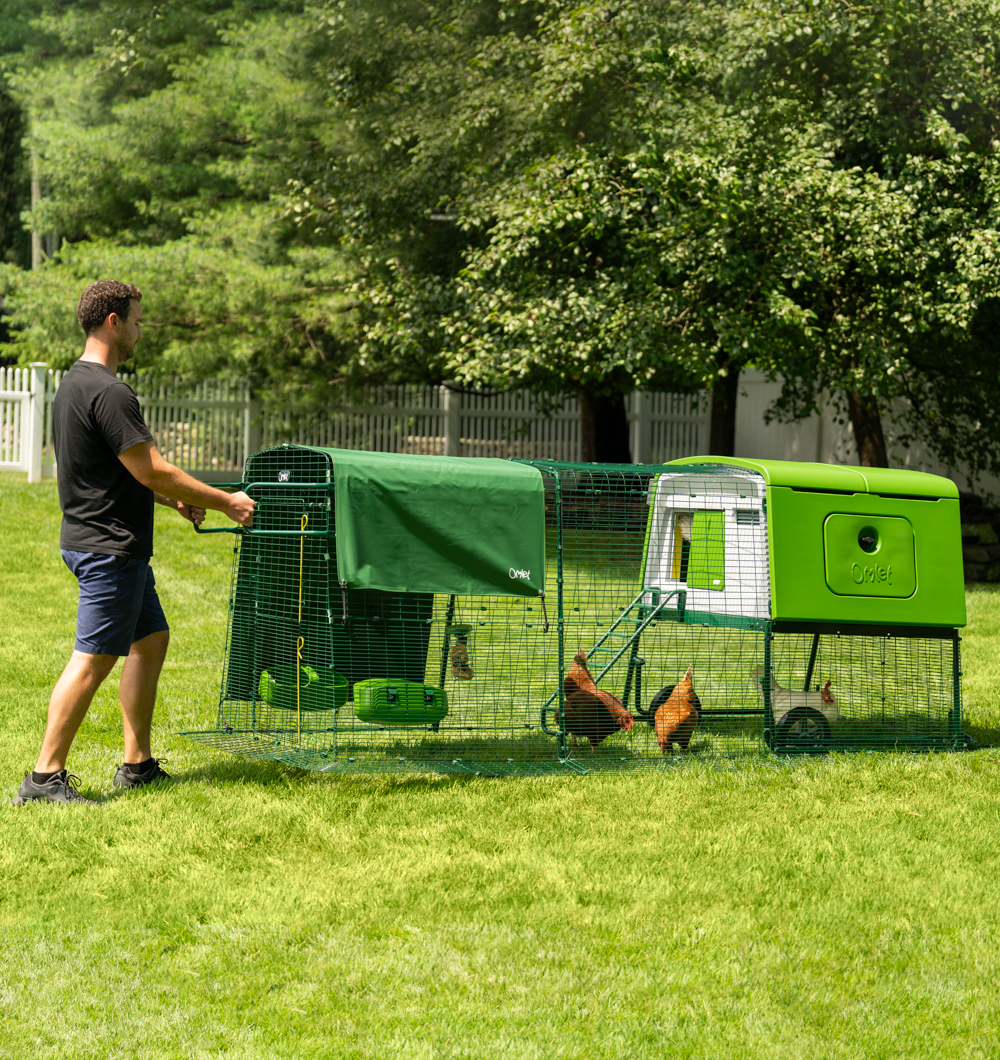
Omlet's easy to move Eglu Cube chicken coop.
Eglu Cube Chicken Tractor
A chicken tractor is a coop with handles and wheels to help move it with ease. Mobile chicken coops are especially helpful in areas of Texas that experience severe weather events, as they can be moved to shelter quickly. Chicken tractors also allow your hens to graze different patches of lush Texas grass!
Eglu Cube with Walk In Chicken Run
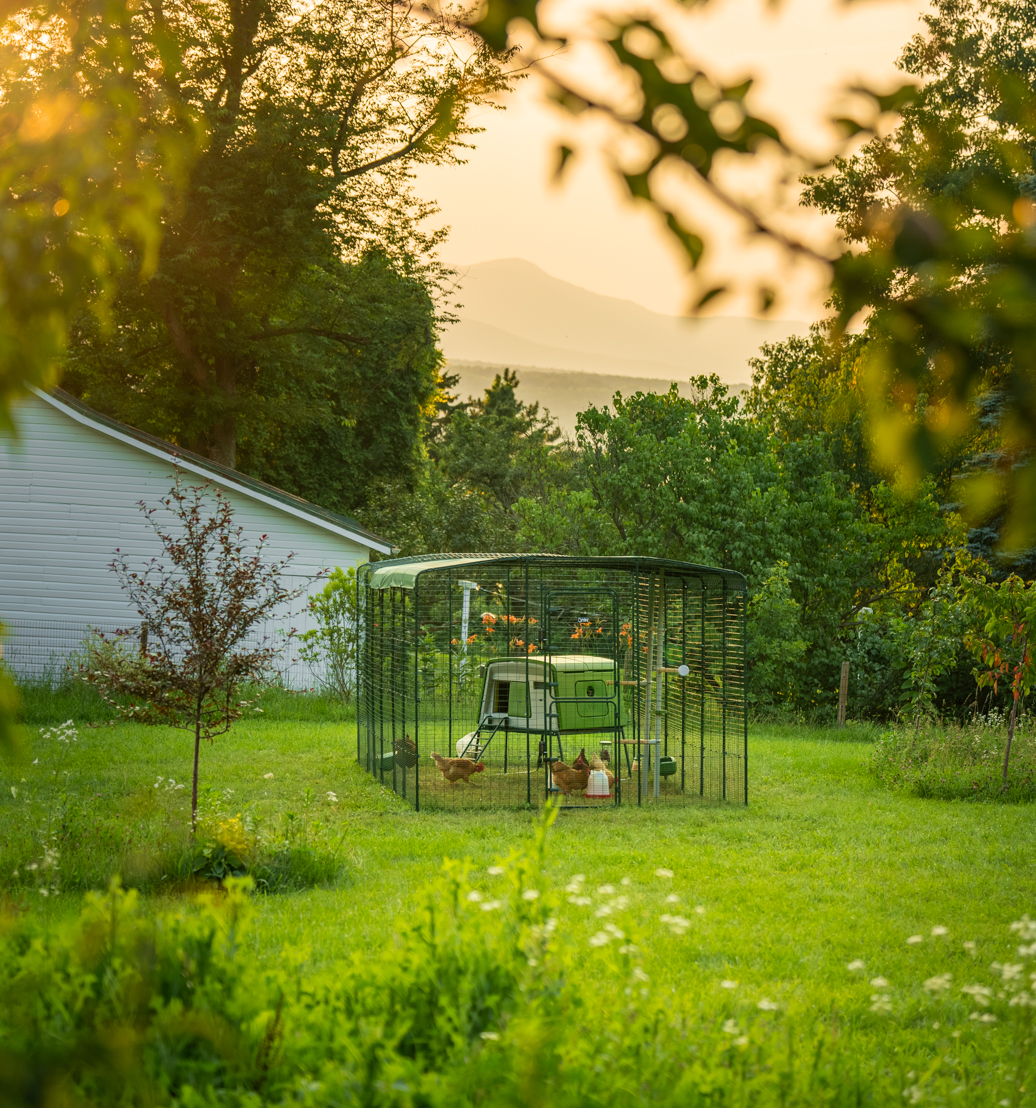
Omlet Eglu Cube in a large Walk In Chicken Run in Texas.
Eglu Cube with Walk In Chicken Run
If you’re ready to lay down some roots with a more permanent setup, an Eglu Cube with an attached Walk in Chicken Run gives your chickens the most space possible. Start off with a standard 6 ft x 6ft walk in run, and expand as large as needed for your growing flock!
Ambassadors
Speak to an Omlet chicken keeper in Texas
Omlet ambassadors are here to help you make the right coop choice for your chickens! They can be contacted by phone, email, video call, or an in-person visit. Find an Eglu owner in Texas on the map.
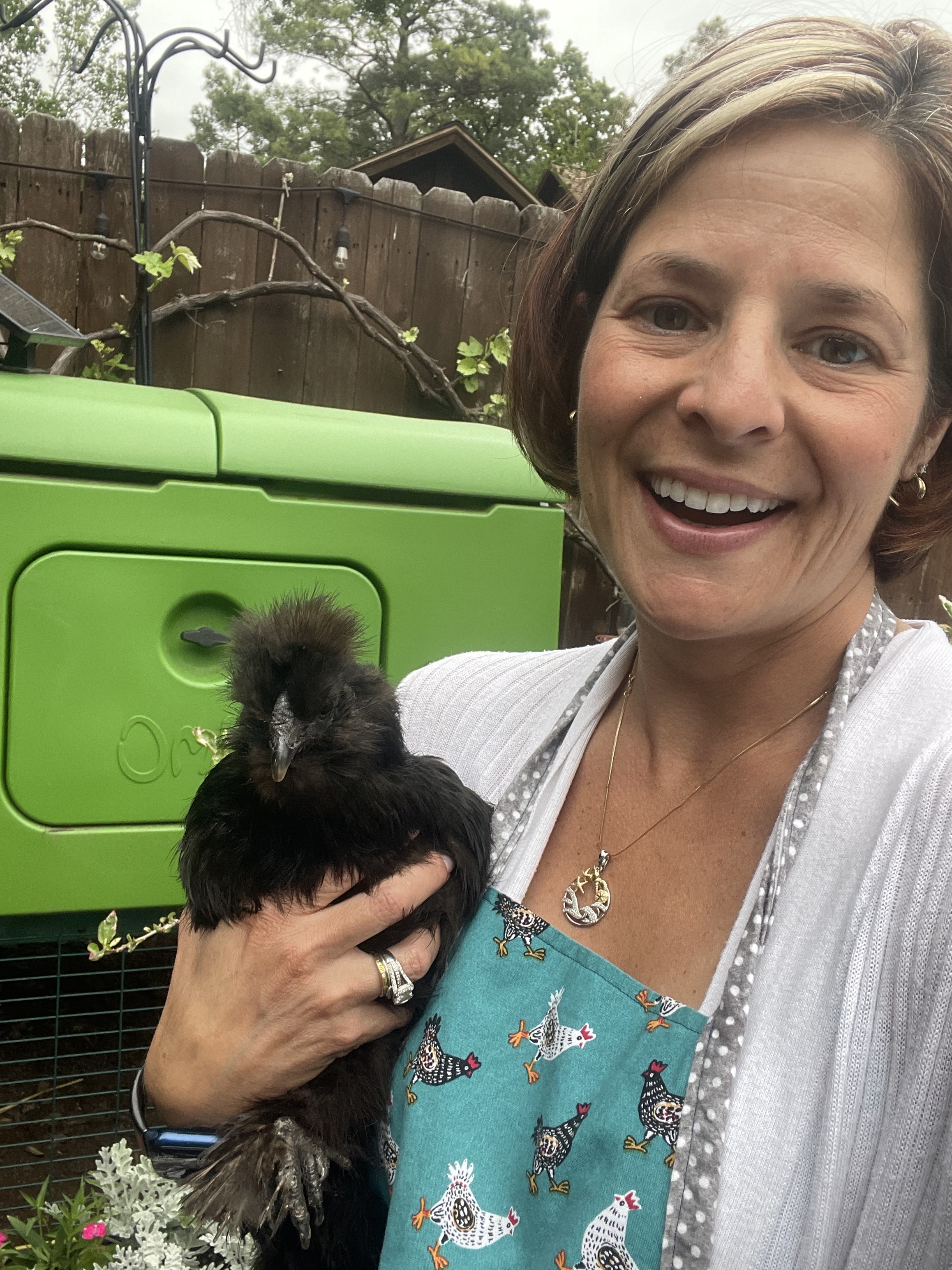
"Making the decision to keep chickens is one of my favorite decisions. Becoming an Omlet Ambassador to help other people on their journey of keeping chicken was the next best decision!"
Chicken keeping Facebook groups in Texas
Find and connect with other chicken keepers across Texas with these Facebook groups:
Protecting your flock from Texas weather
Spring
Spring is an amazing time in Texas, and a favorite among Texas chicken keepers. Bluebonnets are in full bloom, the days are longer, and temperatures are on the rise. For chickens, spring also means more insects to chase and dig up! You may also see your chickens stretching out on the ground for a luxurious Texas sunbath – a sure sign of a happy southern hen!
Spring also marks the start of tornado season across the state. While tornadoes are not uncommon year-round, Texas’ official tornado season runs April-June. This is the time of the year that a strong chicken coop and run can save the day! A chicken tractor is also beneficial when needing to move your flock with little notice.
Summer
As any Texan knows: summers in Texas are legendary! Blazing hot temperatures, high humidity levels, severe weather events, and in some years, drought conditions. But, just as Texans are resilient, so are Texas chickens! As long as you provide ways for your chickens to keep cool, your hens will weather the heat along with you. Offer cooling dust baths, frozen fruits and veggies in chicken treat dispensers, and plenty of shade with chicken run covers.
Chicken keepers in dry, windy west Texas will find that evaporative cooling works wonders for their flocks. A water misting system attached along the top of your chickens’ run will give your hens relief from the dry summer heat. This method isn’t the most efficient in more humid areas of the state, but when combined with a large fan can help your flock experience the evaporative effects.
A coop that keeps chickens cool in summer
The most important asset to any Texas chicken keeper is a well insulated chicken coop, such as the Eglu Cube. Dual-insulation and top-notch ventilation helps keep the temperature down in the hot Texas summer months. The shade underneath the coop gives your hens a reprieve from the sun, while allowing them to enjoy the breeze. And when it’s time for bed, our large chicken coops help keep the temperature and humidity down to a comfortable level.
Summer is also the beginning of hurricane season for chicken keepers along the Texas coast. Hurricane season begins in June and ends in November. While coastal areas are affected the most, hurricanes and tropical storms can wreak havoc all across the state in the form of heavy rainfall and severe storms. A chicken tractor has great benefits when preparing for a hurricane’s arrival. Move to safer spaces or load onto a small trailer or truck bed for evacuations quickly and efficiently through the use of wheels and handles.
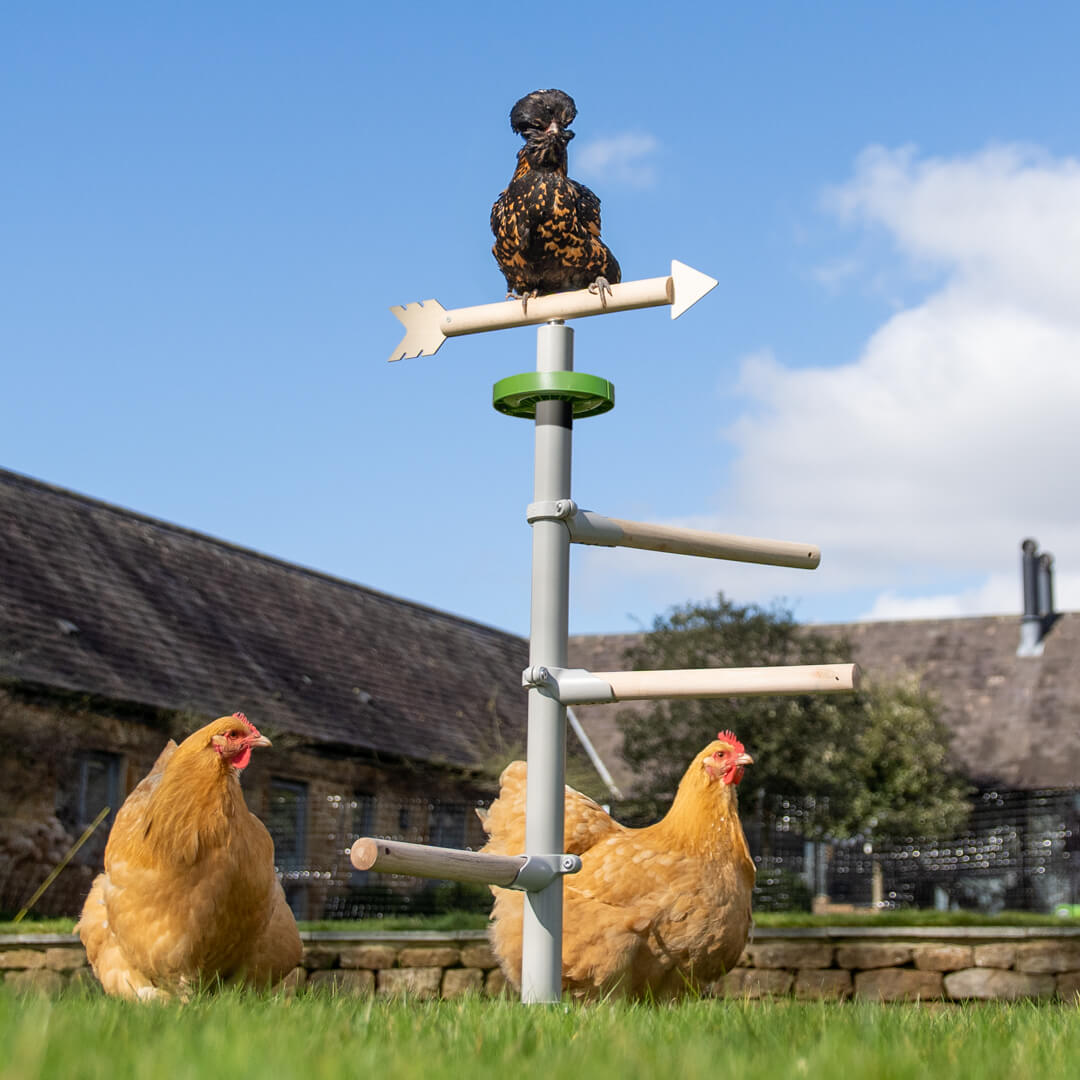
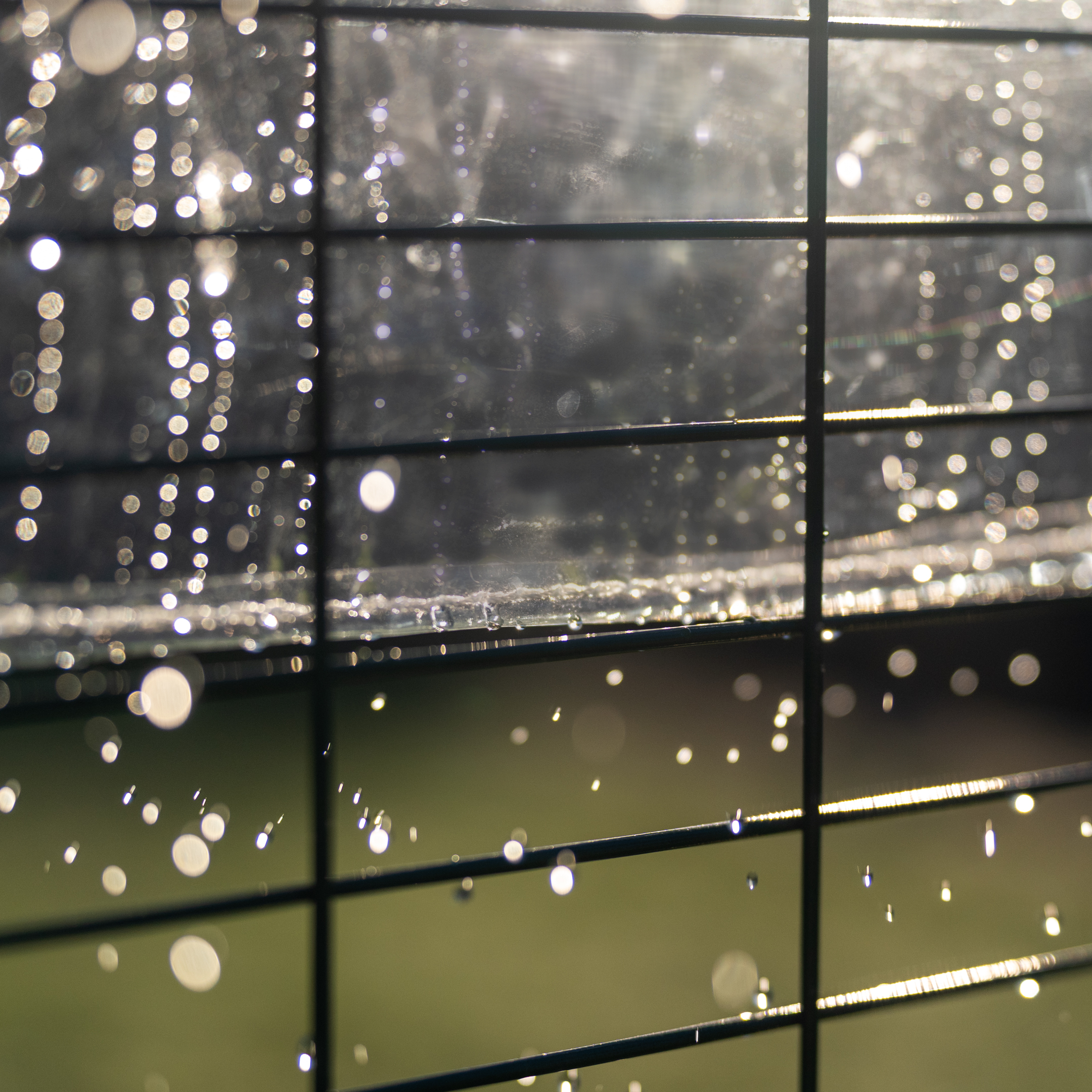
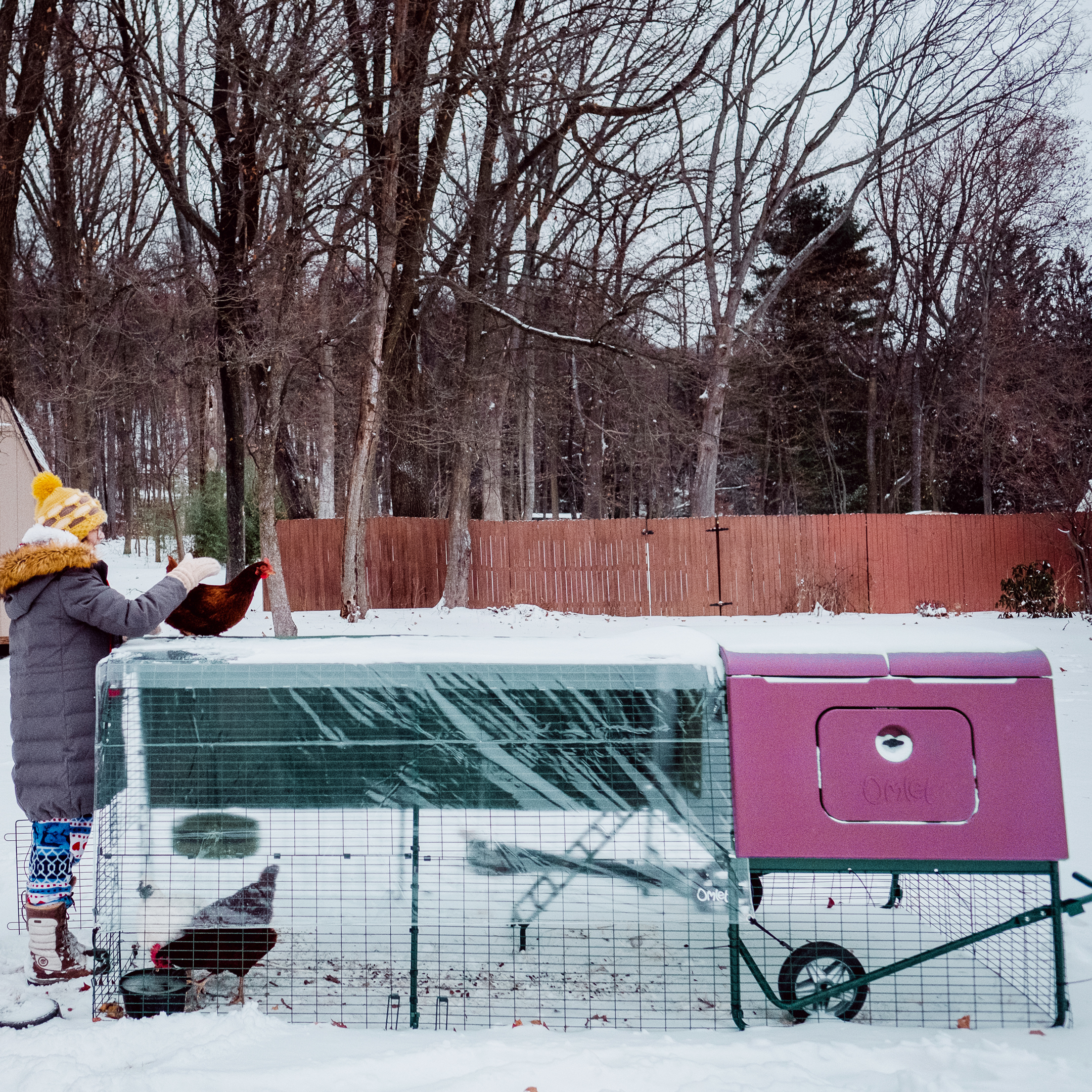
Fall
Fall is another favorite season for chicken keepers in Texas. The temperatures start to drop, making evenings much more comfortable, and falling leaves provide an interesting new layer of ground cover for your hens to peck and scratch their way through. If you have a garden that needs turning for a new planting season, set up chicken fencing around the perimeter and let your flock do the work for you!
Special chicken treats and supplements are a great way to help prepare your chickens for fall. Fall temperatures in Texas are generally mild, but chickens will begin their molting cycle toward the end of the season and will need additional nutrition to help grow new feathers. You may notice your hens looking a little rough around the edges during this time, but they’re shedding their dingy, summer-faded feathers in favor of fluffy, vibrant feathers in preparation for the winter.
Dealing with changing clocks as a chicken keeper
If investing in an automatic chicken coop door is on your wish-list, fall is the opportune time! As the days grow shorter and the nights grow cooler, chickens will seek shelter in their coop earlier each night. Just because Texas chicken keepers have to change their clocks in the fall, doesn’t mean they have to change their chickens’ routine! The AutoDoor can be programmed to keep up with your flocks’ sleep and wake schedule so that you don’t have to adjust yours.
Winter
Texas might not be known for snow, but any Texas chicken keeper can tell you that it’s best to be prepared for cold temperatures! The Panhandle will experience the heaviest amount of snowfall, but cold snaps occur all over the state – seemingly at random and without warning. Thankfully, all that molting in the fall dressed your hens for the changing of the seasons! Chickens have their own natural insulation in the form of downy feathers, and you’ll notice your flock looking more “round” as the days grow colder. Hens will fluff up their feathers to trap air in order to insulate themselves – much like the Eglu Cube!
Chickens thrive in cold temperatures so long as they are able to remain dry and have a place to escape from the cold winter wind. Extra winter weather protection for your chicken coop and run can be added to help your Texas flock through unpredictable winters. Since freezing temperatures and winter precipitation can follow on the heels of several days of spring-like weather, Texas chicken keepers should have winter weather essentials on hand and ready to go on short notice! Chicken run weather covers can be attached quickly and removed easily once winter weather has passed, or can be repositioned along the sides of the run to create a windbreak for both your chickens and their bedding. A raised hen house will keep your chickens’ feet from freezing on the cold ground, and provide a snow-free area underneath.
Severe weather events?
Texas sees it all: flash flooding, severe storms, blizzards, tornadoes, hurricanes, and high winds. But in true Texas fashion, these obstacles can be overcome with planning and perseverance!
For Texas chicken keepers especially, it’s important to have a strong, sturdy chicken coop and run. Heavy duty walk in chicken runs are ideal for all areas of Texas, as they are difficult for high winds or weather events to move or damage. Additionally, a variety of weather protection covers can be utilized based on the need. Bungee hooks keep the covers in place during storms, and the no-gap coverage keeps your flock safe from heavy rains, hail, snow, or sleet.
Texas chicken keepers also need a plan for their flock during severe weather. If you live in an area where hurricane evacuation is a possibility, be sure you have a way to safely transport and temporarily house your chickens in the event you have to leave your home. For short-notice dangers such as tornadoes, mobile chicken coops can be moved on the fly. If you house your chickens in an Eglu Cube attached to the walk in run and are unable to move it, the Eglu Cube has stood up to tornadoes and hurricanes while keeping its hen-inhabitants safe!
Chicken breeds most suitable for Texas
Most breeds of chickens do well in Texas, but given the range of extreme temperatures and weather, some types of hens do better than others. Since the majority of the state experiences warm temperatures most of the year, these are the breeds known to be Heat-hardy:
| Orpington | Barred Plymouth Rocks | Rhode Island Red | Welsummer | White Leghorn |
| Brahma | Wyandotte | Australorp | Ancona | Easter Egger |
Where can I buy chickens in Texas?
Chicks can be found at most feed stores in Texas during the spring and early summer. This is the best time to obtain chicks, as they will need to be raised in a climate controlled area with a brooder lamp for several weeks before venturing out into their coop and run. Transitioning brooder-raised chicks to life outdoors is much easier in the warmer months.
You can also connect with local hatcheries or flock-raisers for chicks, young adults, and full-grown hens. If you have a particular breed in mind, check out Facebook groups, ask other Texas chicken keepers, or contact your local ag-extension office to find a breeder.
Common chicken predators in Texas
A sturdy chicken coop with a secure door is essential to keeping Texas predators disappointed! Many animals native to Texas would gladly try to swipe your chickens and their eggs, and will go to great lengths to do so. Walk in chicken run with enclosed tops keep aerial predators at bay, while the anti-tunnel skirting that comes standard on all Omlet chicken runs helps prevent opportunistic diggers from breaching the run. Chicken predators that Texas keepers will encounter varies depending on location, but predators found throughout the entire state are:
Some areas of Texas also have: bears, mountain lions, foxes, and even alligators.
Most predators lurk in the cover of darkness, so having an automatic chicken coop door to close your chickens in at night will bring great peace of mind. Other predators like snakes and hawks will hunt their favorite prey (rodents) during daylight hours. Keep your chickens’ feed elevated, feed bins securely shut, and pick up any leftover food to cut down on the number of rodents visiting your coop.
Chicken keeping considerations in each of the 7 regions of Texas
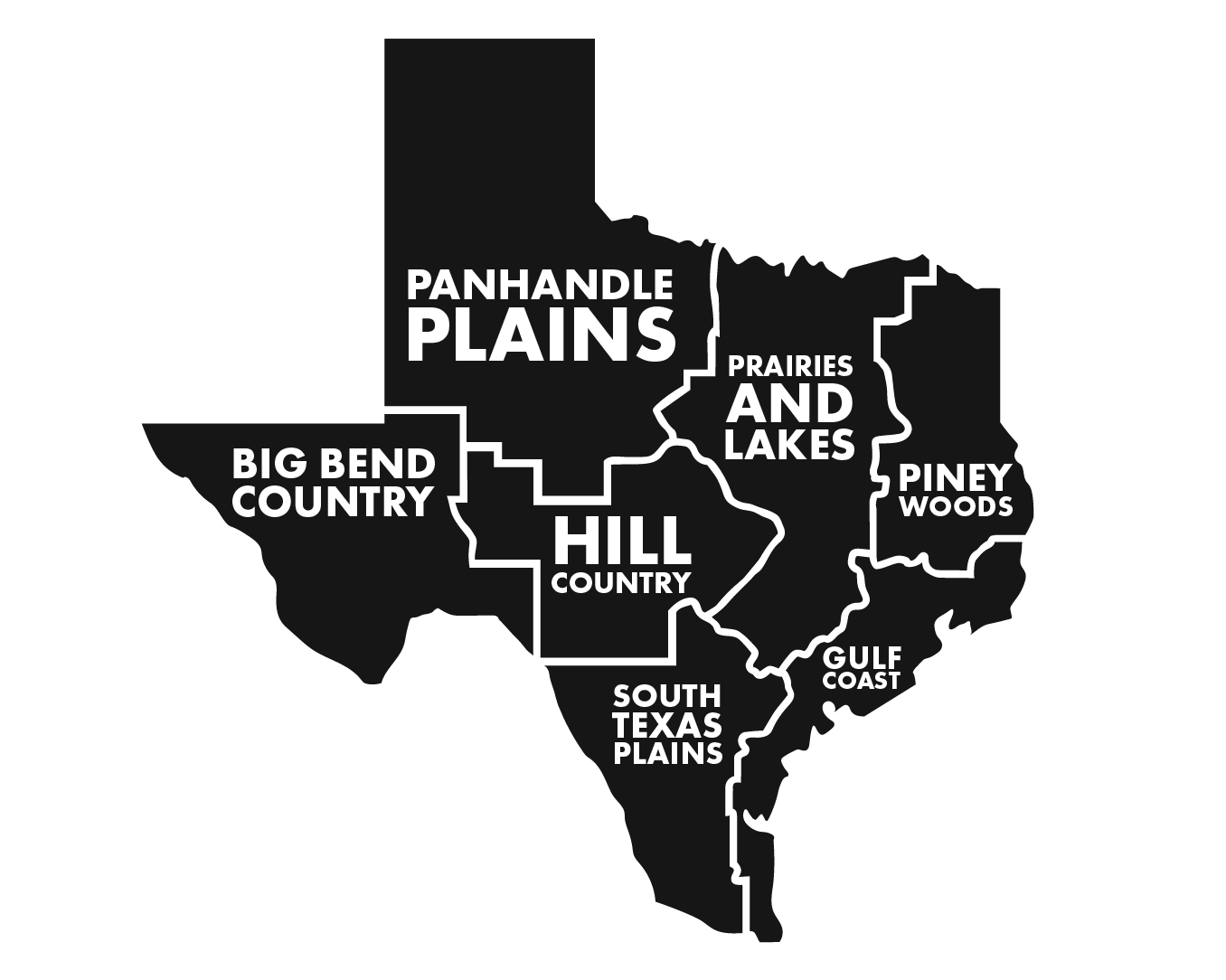
Texas is a vast state. In fact, it’s the second largest in the US (Alaska being the first). At 268,597 square miles, and 7 different regions, Texas offers challenges and advantages to chicken keepers depending on where they find themselves within the state. If you’re new to Texas (or to a new region of Texas), it’s important to familiarize yourself with the terrain, predators, and weather conditions unique to your area. And, as any Texas chicken keeper knows: always prepare yourself and your flock for the unexpected!
Big Bend country
The only mountains found in Texas grace the plateaus and deserts of the extreme western part of the state. Cacti and brush are the predominant varieties of vegetation in the foothills and deserts, while forest trees and shrubs can be found in the mountains. The summers are dry and hot, with cooler nights, and winter brings snowfall annually.
Chicken predators in the Big Bend region include:
Due to the landscape and dry terrain, this area is not prone to tornadoes like the rest of Texas. However, flash floods can occur as a result of the soil content, and proximity to the Rio Grande. Wildfires are also a consideration in this part of the state.
This dry climate gives the opportunity for evaporative cooling measures to help your flock through the hot summer months. Misting systems and fans can be used to help lower the temperature of your chickens’ run.
Gulf Coast
The Gulf Coast region has beaches, islands, prairies, and grasslands. This climate offers mild winters compared to the rest of Texas, but will occasionally experience prolonged temperatures below freezing. The summer months are hot and humid, making it more difficult to keep your flock cool.
Chicken predators common to the Gulf Coast of Texas include:
- Coyotes
- Hawks
- Snakes
- Alligators
- River Otters
Chicken keepers in this part of Texas will need to prepare for hurricane season, which begins in June and ends in November. It’s not uncommon for this region of the state to be subject to evacuations in response to hurricanes or severe tropical storms. Mobile chicken coops would be particularly beneficial for Gulf Coast chicken keepers. Other weather considerations include: tornadoes, flooding, and high winds.
Hill Country
The Hill Country of Texas is centrally located and is so named for its rolling hills and canyons. The terrain is dotted with brush and cacti, and is very rocky. Grass isn’t as abundant in the Hill Country, but other vegetation abounds for your flock.
Chicken predators you’ll find in the Hill Country include:
Weather conditions of the Hill Country are more mild than the majority of Texas, with less snowfall in the winter and lower average highs in the summer. Humidity levels and weather events are moderate, making this area ideal for Texas chicken keepers.
Severe weather events aren’t common in the Hill Country, but the terrain creates an opportunity for flash flooding during periods of heavy rainfall. Other special considerations include unlevel and rocky terrain, which may warrant chicken coop and run modifications.
Panhandle
The northern most part of Texas is flat with very few trees. Plains make up the majority of this region, with lots of farmland. Lower humidity, dusty soil, and wind are trademarks of the Panhandle. In fact, this part of Texas is one of the windiest regions in the entire US, so chicken coops and runs should be firmly anchored to the ground.
Chicken predators include:
The Panhandle Plains experience the most average snowfall in Texas, with lower sustained winter temperatures than the rest of the state. Its flat terrain also makes the Panhandle susceptible to tornadic activity.
Pineywoods
The far eastern part of Texas is referred to as “Pineywoods” due to its dense pine forests. This wooded area also contains marshes and swamps, and lots of hardwood trees. Vegetation is abundant, as are grasses and insects for your flock. This region experiences high humidity and summer temperatures.
Chicken predators for the region include:
As the wettest part of Texas, the Pineywoods region experiences lots of rainfall – and storms. Hailstorms, tornadoes, and flooding are all common in this part of Texas. Chicken keepers in this region must remain vigilant in getting their flock inside their coop when severe weather is approaching.
Prairies and lakes
The prairies and lakes region of Texas also offers wooded areas, rolling hills, and farmland. As its name suggests, this area is abundant with bodies of water and grasslands, with lots of grazing opportunities for chickens. Fun fact: this region was once home to several species of dinosaurs, including the Tyrannosaurus Rex – distant cousin to chickens!
Present-day chicken predators for this region include:
As a transitional region between the Panhandle Plains and Pineywoods, the climate varies greatly and sometimes suddenly. Temperature fluctuations are common at the changing of seasons, and heavy rainfall, tornadoes, flooding, and hailstorms are all common. Cold snaps are more common than sustained sub-zero temperatures in the winter, but moderate to high humidity levels can make these dangerous for chickens. The summers are long and hot. Despite these challenges, vegetation is abundant for chickens, making this area of Texas one of the most popular among chicken keepers.
South Texas Plains
Most of the South Texas Plains are dry, covered in cacti, thorny bushes, and rocky soil. However, farther south along the Rio Grande river offers a subtropical environment with high humidity, which makes for an interesting and unique contrast. Farmland is abundant in this part of the plains, as is wildlife.
Chicken predators found in this region of Texas include:
- Coyotes
- Hawks
- Owls
- Feral hogs
- Mountain lions
- Ocelots (rare)
- Coatis
- Foxes
- Weasels
The contrasting climates within this region make for moderate seasons. Temperatures are warm in the summer, but still below the state average. Winters are mild and snowfall is rare. Keeping chickens in this part of Texas is met with fewer challenges than other parts of the state.
Do I need permission to have a chicken coop in Texas?
Each town, city or county in Texas has different chicken coop zoning regulations, usually focusing on permanence, height and location. Additionally, if your home is part of a homeowners association (HOA) or otherwise subject to zoning restrictions, you’ll need to ask permission before obtaining chickens. Some restrictions may apply to roosters or the number of chickens you can house. Permits may also be required when considering a chicken coop.
What your area defines as a structure that requires a permit can vary, but permits are not usually needed for any structure under a certain number of square feet, so compact and mobile chicken coops like the Eglu Cube usually do not require a permit.
How many chickens can I keep in Texas?
This is again left up to individual towns, cities, counties, or other governing authorities in Texas. In general, the size flock you can keep will be relative to the size of the lot your home occupies. Some cities are generous with their backyard flock sizes, while others are quite restrictive. Contact your city offices, town hall, or animal control officer to find out specific chicken keeping guidelines.
Caring for your flock with Omlet
Keeping chickens in Texas is easy with Omlet’s range of chicken coops and accessories. Designed by experienced chicken keepers, the Eglu chicken coops and walk in chicken runs are engineered to keep your chickens safe from the wild weather and predators that are native to Texas. Add innovative chicken perches and chicken peck toys to your hen’s space to provide entertainment and enrichment – for you and your flock!
Local Pictures
Comments Leave a comment
There are no comments just yet